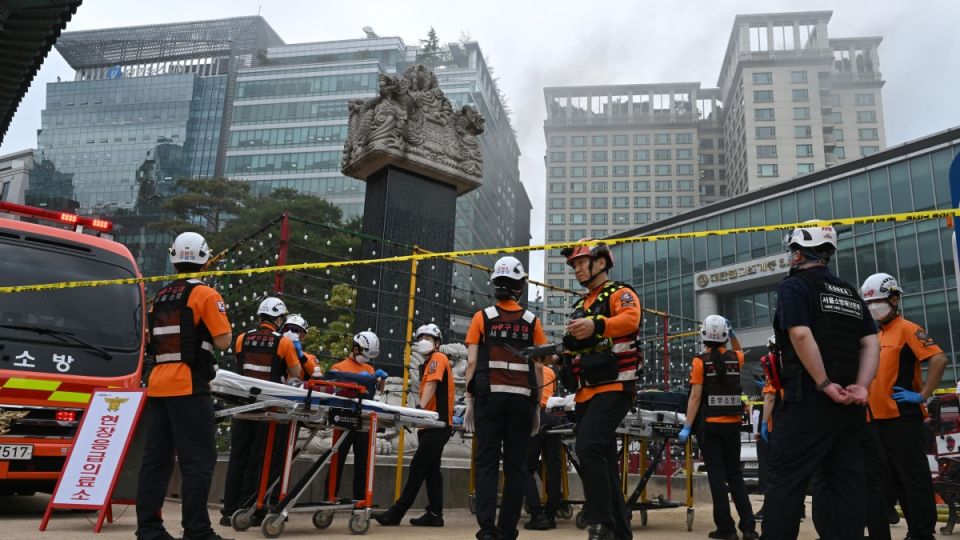September 30, 2025
SEOUL – The South Korean government said Monday that it will take up to a month to fully recover 96 core systems directly damaged in Friday’s fire at the National Information Resources Service in Daejeon, signaling prolonged disruptions in public administration.
At a press briefing at the government complex in Sejong, the Ministry of Interior and Safety’s Vice Minister Kim Min-jae said the government planned to relocate and rebuild the damaged systems using the public-private cloud cluster based in the NIRS headquarters in Daegu.
The timeline the government has laid out as of Monday spans at least a month, with two weeks for securing the necessary information infrastructure and two weeks for system construction. This is longer than the mooted timeline of at least two weeks given by the Interior Ministry on Sunday.
“We are aiming to shorten the schedule as much as possible by cooperating with the Daegu center,” said Kim.
As of 4 p.m. Monday, just 73 of the 647 government services affected by the fire had been restored, according to the Central Disaster and Safety Countermeasures Headquarters.
Out of the 36 services that fall under the government’s “Grade 1” category — systems deemed essential based on user impact and service importance, only 20 of those services, or 55.6 percent of the 36 services, were restored as of 6 p.m.
Authorities have conducted three forensic inspections at the NIRS headquarters since the blaze was fully extinguished Saturday.
The Daejeon Metropolitan Police Agency said Monday that it brought in 20 specialized forensic investigators, including three lithium battery experts, to speed up efforts in determining what triggered the fire.
Friday’s blaze, which broke out in a server room at the NIRS headquarters in Daejeon, has left hundreds of government services paralyzed for days.
The NIRS serves as the backbone of South Korea’s e-government system, integrating and operating the IT infrastructure for central ministries and local governments.
While 1,600 systems are distributed across three sites in Daejeon, Gwangju and Daegu, over one-third of its systems are based at the Daejeon site.
When the fire broke out at the Daejeon headquarters, all 647 systems went offline simultaneously, including Government 24, online postal services and the 119 emergency call system. Of the 647 impacted systems, 96 were directly destroyed in the fire, while 551 were shut down preemptively to prevent further heat damage.
Some government services offered through the Gwangju and Daegu headquarters continued, but the inability of the civil application services to switch over in real time highlighted the absence of a “twin server” architecture. This refers to a real-time backup system that mirrors the primary one to ensure uninterrupted service during outages.
Information security experts stated that the absence of this type of server highlighted a critical weakness in Korea’s data management framework.
“Grade 1 government systems, or systems whose disruption scores over 90 points based on user impact and service importance, should have been backed up in a fully mirrored environment elsewhere,” said information security professor Kim Myuhng-joo of Seoul Women’s University.
“Given the scale of social and economic disruptions that come from nationwide civil application service outages, grade 1 government systems must be managed under frameworks that allow for immediate switching in emergencies.”
Kim said nationwide disruptions in administrative services have persisted because the government lacked a fully duplicated disaster recovery system capable of replicating not only files but entire operating environments. The government has faced criticism for this gap, especially since a massive network outage of administrative systems in November 2023 had already prompted calls to implement such a system.
The opening of cloud center equipped with disaster recovery systems in Gongju, South Chungcheong Province, has been stalled for 13 years. Though construction finished in May 2023, its official launch was continuously delayed due to budget constraints. In 2024, a budget of 25.1 billion won ($17.9 million) earmarked for installing IT infrastructure went unspent, and in 2025, just 1.6 billion won was allocated, leaving the center dormant.
“The (November 2023) incident should have been the moment to enforce active-active redundancy, where backup servers synchronize in real time,” Kim continued. “Without that, the risk of data loss or prolonged downtime remains significantly high, as evident from Friday’s fire. The government should also consider using private cloud infrastructure to ensure civil services remain available.”
With less than 10 percent of government services restored three days after the fire, Interior Minister Yun Ho-jung apologized for the inconvenience caused by the administrative disorder over the weekend, adding that inconveniences will likely continue for some time.
“The government will push to relocate the damaged systems to a cloud at the NIRS branch in Daegu and quickly come up with alternatives to reactivate the damaged systems,” he said, adding that ministries and local governments have been instructed to minimize disruptions as best they can.
For systems not impacted by the fire, restoration work is ongoing, and more services are expected to resume every hour. The government anticipates the remaining 574 services to resume in one to two weeks.
Meanwhile, the Board of Audit and Inspection stated on Monday that the NIRS was linked to long-standing problems in outdated equipment management in November 2023.
The BAI’s audit of administrative information systems, conducted in 2024 and finalized this August, found that system failure rates at the NIRS rose significantly once its equipment had been used for four to seven years. Yet, the agency had uniformly applied extended “durability periods” of six to nine years, effectively delaying replacements.
As a result, some devices recorded average failure rates of over 100 percent before reaching their adjusted replacement timelines, the report added.
lee.jungjoo@heraldcorp.com


